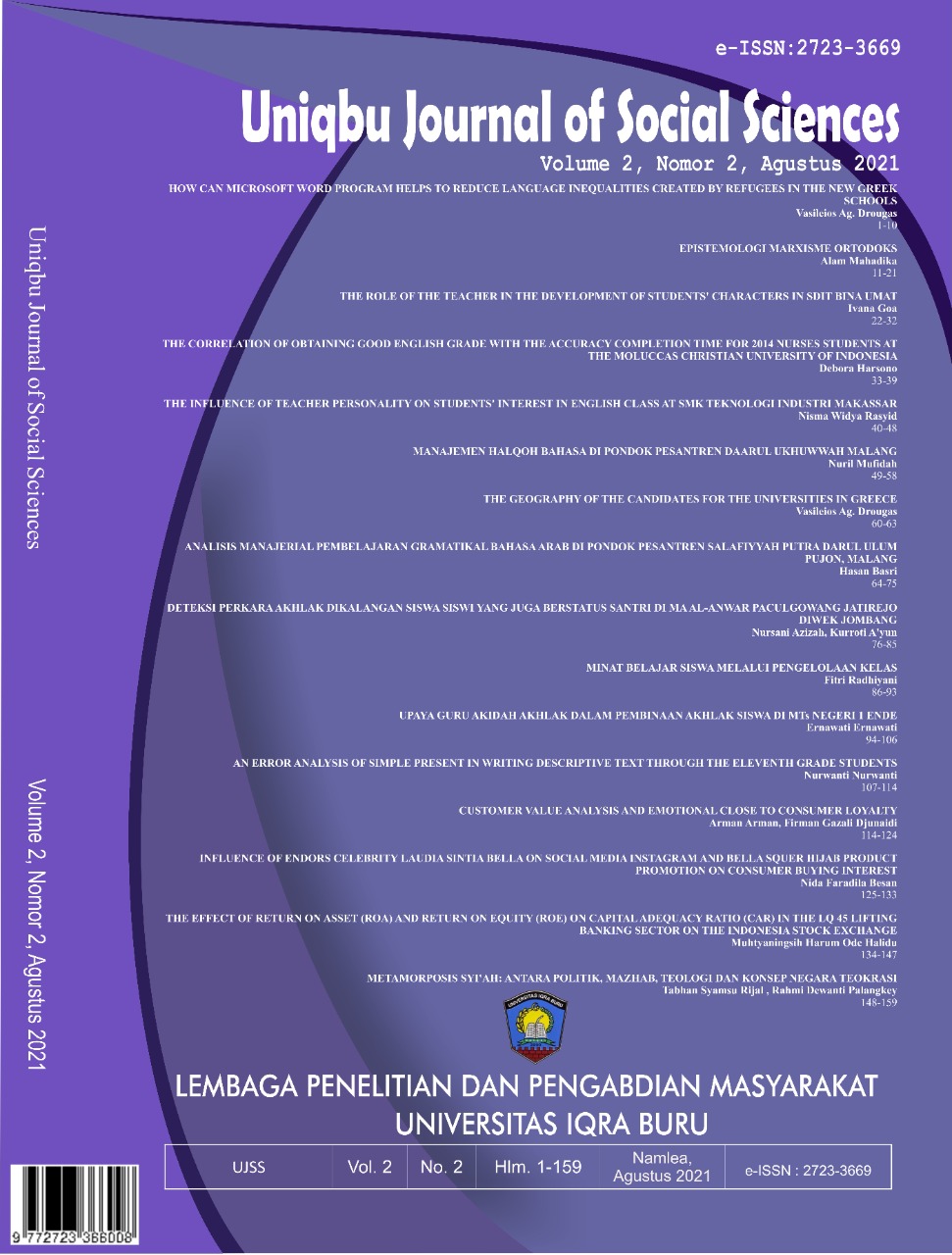AN ERROR ANALYSIS OF SIMPLE PRESENT IN WRITING DESCRIPTIVE TEXT THROUGH THE ELEVENTH GRADE STUDENTS
Analisis Kesalahan Simple Present Dalam Menulis Teks Deskriptif Pada Siswa Kelas Sebelas
DOI:
https://doi.org/10.47323/ujss.v2i2.141Abstract
The research was conducted to identify the errors are made by the eleventh grade of IPA students at Madrasah Aliyah Al Ikhlas Amberi in writing descriptive text by using simple present. The objective of the research is to find out the type of errors made in writing descriptive text by using simple present. This research applied descriptive qualitative research method by using Surface Strategy Taxonomy to analyze the data. The result of this research showed that the total of errors were 279 errors. The proportions (frequency and percentage) of the students’ error in writing descriptive text by using simple present was, students made errors in omission type were 27 students with 74 errors or 26,52% of errors, students made errors in addition type were 19 students with 37 errors or 13,26 % of errors, students made errors misformation type were 30 students with 142 errors or 51,00 % of errors, and students made errors in misordering type were17 students with 26 errors or 9,31 % of errors. From the data above, it could be concluded that misformation type was the highest number of errors made by the students and misordering type was the lowest number of errors made by the students.
References
Alfiyani, Lulu Meilina. 2013. An Analysis of Grammatical Errors in Writing among the second Semester Students of English Department of Yogyakarta State University in the Academic Year of 2011/2012. Published Thesis. Yogyakarta: Univeriitas Negeri Yogyakarta. Retrieved from https://www.google.com/url?sa=t&rct=j&q=&esrc=s&source=web&cd=&cad=rja&uact=8&ved=2ahUKEwi9o_K_qK7yAhVGU30KHcK1B6sQFnoECAgQAQ&url=http%3A%2F%2Fsimki.unpkediri.ac.id%2Fmahasiswa%2Ffile_artikel%2F2015%2F11.1.01.08.0118.pdf&usg=AOvVaw2fwB6tolkwqzmFevGnERvi.
Azar, Betty Schrampfer. 1989. Understanding and Using English Grammar. Second Edition. New Jersey: Prentice Hall.
_________. 2002. Understanding and Uisng English Grammar (Third Edition). New York: Longman.
Brown,H.2007. Principle of Language Learning and Teaching. New Jersey: Practice Hall Inc.
Davies, P. and Pearse, E. 2002. Success in English Teaching. Shanghai: Shanghai Foreign Language Education Press.
Dulay, H. et.al.. 1982. Language Two. New York: Oxford University Press.
_______. 1997. Second Language Acquisition. New York. Oxford University Press.
Knapp, P., & Watkins, M. 2005. Genre, Text, Grammar. Sdyney: University of New South Wales Press Ltd.
Krohn & Robert. 1971. “English Sentences Structure. Jakarta: Binarupa Aksara.
Maleong, L.J. 2004. Metodology Peneltian Kualitatif, Bandung: PT. Remaja Rosdakarya.
Martin, L. J. & Kroitor, H. P. 1980. English Text: System and Structure. Amsterdan:John Benjanmis.
Muhsin, M.A. 2016. Analyzing the Students in Uisng Simple Present (a case study at Junior High School in Makassar). Makassar: Pacific Science Review B.
Nunan, David.2005. Practical English Language Teaching: Young Learners. New York: Mc Graw-Hill.
___________.1999. Second English Langauge and Learning. Boston. Heinle and Heinle Publisher.
Nation, I.S.P. 2009. Teaching ESL/EFL Reading and Writing. New York: Routledge.



